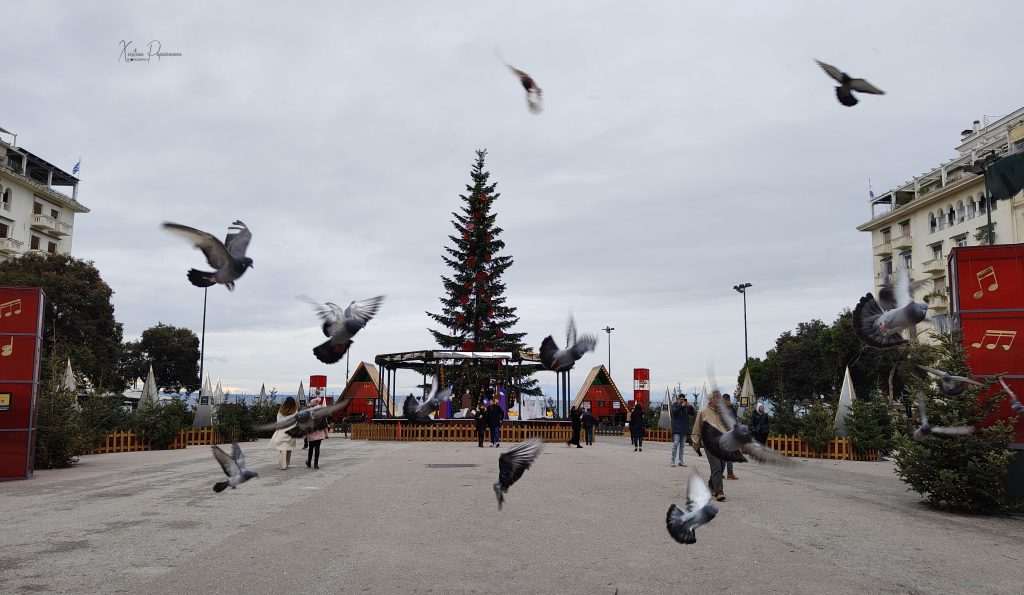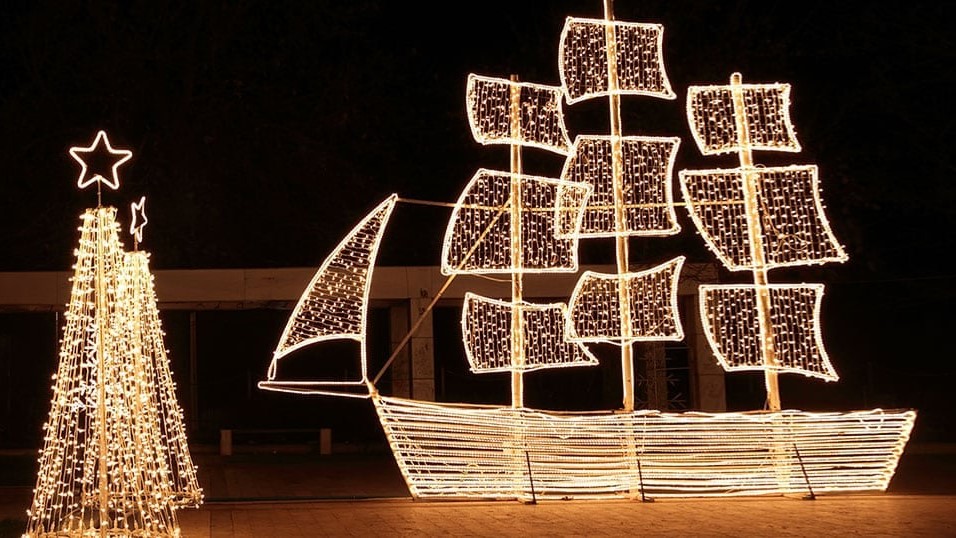By Marina Siskos.
Festivals have been a part of human life since antiquity. Traces of our past Christmas customs and celebrations are found everywhere, from decorations, habits, to culinary creations. The past is diffuse in the Christmas celebrations of today, and it is more than exciting to relive the customs established by our ancestors.
Folk spirit is present in many more events and habits of the Nativity than we imagine. The reason why folklore persists through time and space is because the things people traditionally make with their words, hands and actions, continue to give pleasure, and satisfy artistic impulses common to the species. Folklore persists also because it continues to meet basic human needs.
In the calendar, the period stretching from Christmas Eve to the Epiphany, is the “Twelve Days of Christmas” and it includes most of the Christmas customs. While some Christmas customs came to us from other places, for example Mexico, where from comes the turkey, and others from Europe, such as the Christmas tree, or the American Santa Claus, most customs celebrated in Greece are native.
Pourpouris, Thrace:
Pourpouris is a performative custom, with its main characters, the goatish Pourpouris and his beloved wife, Kortopoula. This is part of the Ragoutsaria rituals, the masquerades moving about and singing the festive, traditional “kollianta”, the Christimas carols. Pourpouris has a rich history, tracing back to the Asia Minor refugees. It is mainly honoured in Isaakio, the lowlander village of Thrace. Pourpouris arrived with the 1922 Sakpasiotes refugees, from the seven villages opposite Eastern Thrace, during their relocation there.
Pourpouris is the name of the goblin-looking, horn-carrying creature, who is vested in sheepskin and goes around the village homes, singing the kalanta. His sheepskin is elaborately embroidered with traditional patterns, protecting him from the notoriously bitter winter of Thrace. Traditional, instrumental music of Thrace, with the indispensable bagpipe melody (gkaida), accompanies the adventurous performance. Pourpouris wears large, loud bells, and his fearsome disguise is meant to scare the evil spirits away from the village, forcing them to disappearance during this holy celebration.

Kortopoula is his wife and, in the custom, the balancing element of the male. This is despite the fact that, Kortopoula is actually a man in disguise. She stands for the fertility of the land and, in consequence, the anticipated springtime and the blossoming of the nature. Pourpouris will furiously chase away any man who attempts to approach Kortopoula. Pourpouris is usually revived on the second, sometimes the third day of Christmas, as it was established by the original residents of Isaakio village.
The Camel, Macedonia:
It is another performative custom, originating from Eastern Romilia and it is relived either on the Christmas, or the New Year’s Eve. It is celebrated in Giannitsa, Galatista of Chalkidiki and Thermi, the eastern district of Thessaloniki. The young people of the village gather and construct a wooden frame, which they vest using relics and pieces of leather. Once the camel frame is ready, two young men carry it and “give” their legs to the camel. The camel is driven by the camel jockey, accompanied by the traditional sounds of the baidouska dance. The camel goes around the village and people offer as a gift, sausages, and money. The camel then, in expression of gratitude, kneels to the ground. During the procession, the camel would go astray, making the people chase after her and beat her; this is an allusion to the hardships and the adversities anyone is doomed to withstand in the course of a lifetime. The bibliography on the exact origins of the custom might be fragmentary, but the similarity to the Trojan horse is inevitable.
The Decorated Christmas Ships, Aegean Sea, Chios Island:
Greece has always been a marine force, proud of its ancient naval history. Hence, the reference to the sea and its people is part of the Christmas custom of the ships, honoured in Chios. They are called the ships of Saint Nicholas.
The custom is performed on New Year’s Eve, taking place at the central square, where children and young people from every neighbourhood gather, bringing their ships. Grouped in teams, they have the mission to construct a ship that is strikingly similar to a real one, be it a cargo or a warship.
Apart from the replicas, the children also create the appraisals (painemata), that is, poems recited as carols, expressing wishes for the families of the marine professionals, and, occasionally, contemporary satire, parodying political events.

The competing craftspeople need roughly three months to complete the construction of the Christmas ships. There is a prize for the best ship, and the decorated vessels sails around, accompanied by festive melodies. Regarding the origins of the custom, one theory suggests that it traces back to the Anthesteria, during which, God Dionysus entered Athens and other Ionian cities.
Since the Balkan Wars (1912-13), the custom has been crystallised to its present state. New, sturdier materials started being used, and the constructions were obtaining more characteristics of the real ship, like their funnels. The arrival of 1922 Asia Minor refugees renewed and enriched the symbolic value of the performance.
Feeding the water spring, Thessaly:
In the villages of Thessaly, at midnight on Christmas Eve, people enliven the custom called “the feeding of the water spring”. Young village girls spread butter and honey on the water springs of the village, wishing for abundance and prosperity, like the running water, and for a sweet new year, like the honey. Then, they take the so-called “silent” water home. The transition and the return to the source is silent, hence the water they carry is called “silent”, and they use it to spray their homes to bring health, fortune and good luck.

To establish healthy and abundant crops, the young ladies go back to the source to lay butter, cheese, or roasted wheat grains. Alternatively, they bring an olive branch, or legume, all of them as an offer for rich crop. They perform a race on their way to the spring, and the first to arrive there is considered the lucky one for the anticipated year.
Feasts and festivals are viewed as “acts which reproduce the great systems of beliefs and mythologies”, and they are “understood as celebrations of social and religious rites and consolidating basic social groups”. Their celebration reinforces established society and social convention.
Surprisingly, most of the traditional Christmas customs are celebrated and preserved through time. They are vastly different, adding to the endless interest and richness of this country. The co-existence of the modern and the traditional, combine to an unparalleled festive scenery, making everyone look forward to this family holiday. Christmas and the New Year’s Eve have always been highly celebrated as they represent the arrival of the new, the pure and the divine, and herald the onset of a better and brighter future.
References
- Archailogia.gr. (2016). H «Μπάμπω» και ο «Πουρπούρης». Θράκη: Δώδεκα Μέρες Γιορτής. Η «Μπάμπω» και ο «Πουρπούρης» (archaiologia.gr).
- Cudny, W. (2014). The Phenomenon of Festivals: Their Origins, Evolution, and Classifications. Anthropos, 2014, Bd 109, H2 (2014), p.p. 640-656, Nomos Verlagsgesellsschaft mbH, https://www.jstor/stable/43861801.
- Iefimerida.gr. (2018). Το Τάισμα της Βρύσης και Άλλα Χριστουγεννιάτικα Έθιμα και Μεζέδες της Στερεάς Ελλάδας. Το «τάισμα της βρύσης» και άλλα χριστουγεννιάτικα έθιμα και μεζέδες της Στερεάς Ελλάδας – iefimerida.gr.
- Μηχανή του Χρόνου. (2018). Τα ‘Αγιοβασιλιάτικα καραβάκια’ της Χίου. Το έθιμο με το οποίο τιμούν τους ναυτικούς, παραμονή Πρωτοχρονιάς. Δείτε την απαιτητική προετοιμασία και το μεράκι των κατοίκων. Τα «Αγιοβασιλιάτικα καραβάκια» της Χίου. Το έθιμο με το οποίο τιμούν τους ναυτικούς παραμονή Πρωτοχρονιάς. Δείτε την απαιτητική προετοιμασία και το μεράκι των κατοίκων (βίντεο) – ΜΗΧΑΝΗ ΤΟΥ ΧΡΟΝΟΥ (mixanitouxronou.gr).
- Σαραντάκης, Β. (2008). Το Έθιμο της Καμήλας. www.patridamou.gr/?p=279.
- Τόποι και Τρόποι. (2015). Τα Αγιοβασιλιάτικα καραβάκια της Χίου. Έθιμο της Πρωτοχρονιάς. Τα Αγιοβασιλιάτικα καραβάκια της Χίου – Έθιμο Πρωτοχρονιάς | Τόποι και Τρόποι (topoikaitropoi.gr).
- Wilson, W. A. (2006). Documenting Folklore. In J. T. Rudy & D. Call (Eds.), Marrow of Human Experience, The: Essays on Folklore by William A. Wilson (pp. 81–104). University Press of Colorado. https://doi.org/10.2307/j.ctt4cgkmk.10.
- Siskos, M. (2022). Pourpouris. The Folklore Thracian Christmas Custom. The Greek Herald. Poupouris: The Folklore Thracian Christmas Custom – Greek Herald.

